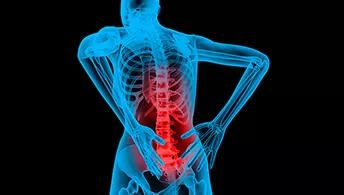The vertebrae of the spine are stacked on top of each other, providing strength and stability with in the body. On each side of every vertebrae are small joints known as facet joints; facet joints in the upper, or neck region, of the spine are called cervical facet joints.
Pain occurring in the cervical facet joints is most often the result of inflammation caused by the degeneration of cartilage, increased friction between vertebrae, and as a result of bone spurs that have formed in and around the joint. Facet syndrome, or facet pain, can occur anywhere in the spine; the condition, when occurring in the neck or cervical region of the spine, is commonly known as cervical facet syndrome.
Causes of Cervical Facet Syndrome
Cervical facet syndrome is one of the most commonly reported recurrent neck problems; left untreated, cervical facet pain can result in serious and painful symptoms that result in disabling conditions.
Generally attributed to the natural aging process and normal “wear and tear” on the joints in the neck, cervical facet syndrome can also be caused by injuries occurring in the joints.
Other causes that result in cervical facet syndrome include:
- Spondylolisthesis
- Cervical discs
- Osteoarthritis
- Bone spurs
- Neck trauma, including whiplash
Symptoms
Symptoms related to cervical facet joint problems typically occur in and around the area of the affected facet joint, and include:
Intermittent and unpredictable episodes of pain and discomfort that can occur on occasion, including as often as a couple times a month or as infrequently as a few times a year.
Tenderness around the inflamed area.
Reduced flexibility in the muscles around the inflamed cervical joint.
Discomfort and pain in the neck while moving the head forward, backwards, and side to side
Pain associated with cervical facet syndrome may also radiate sensations of pain, tingling, or discomfort into the, shoulders and upper back area
The vertebrae of the spine are stacked on top of each other, providing strength and stability with in the body. On each side of every vertebrae are small joints known as facet joints; facet joints in the upper, or neck region, of the spine are called cervical facet joints.
Pain occurring in the cervical facet joints is most often the result of inflammation caused by the degeneration of cartilage, increased friction between vertebrae, and as a result of bone spurs that have formed in and around the joint. Facet syndrome, or facet pain, can occur anywhere in the spine; the condition, when occurring in the neck or cervical region of the spine, is commonly known as cervical facet syndrome.
Diagnosis
Cervical facet syndrome is easily diagnosed by a medical professional. After completing a physical examination and reviewing a patient’s medical history, a doctor suspecting this condition will administer a diagnostic facet injection, which numbs the area in and around the facet joint. Pain that goes away after this injection is often the conclusive indicator supporting the diagnosis of cervical facet syndrome.
Possible Treatments
Treatment of cervical facet syndrome depends on the severity of the pain and discomfort associated with the condition. In most cases, treatment will start with non-surgical options designed to manage and alleviate pain while the joint heals, and includes:










